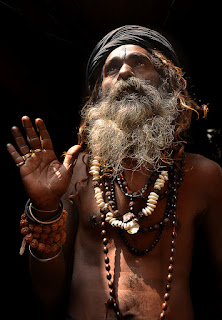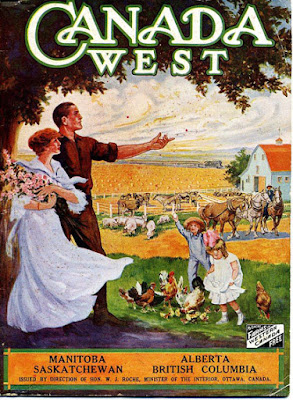The Sadhus, in Varanasi, and elsewhere in India, are the bizarrely costumed holy men who renounce the world and its earthly pleasures and spend their days and nights in meditation and prayer. Varanasi was crowded with them. Some we saw were likely imposters, perhaps all of them: it's well known that many of these people gear up every day and basically beg for money. If they look the part, excellent money can be made, so we heard. Tourists love to pose with these shysters; we watched German tourists nearly swooning in religious fervor, hanging on every word being uttered by one of these people. Was he the "real deal" or an imposter? Somehow it seems to me that the true Sadhus would not be interacting with tourists at all! Have I grown too cynical?
 |
| My Sadhu-I greased his palm as indicated. You have to admit his costume is a Wow! |
 |
| Flickr: mag brinik |
 |
| Flickr: mag brinik |
 |
| Flickr:mag brinik |
In Varanasi they could be seen on the streets, on the ghats, at the funeral pyres, at the ceremonies. A pilgrimage to Varanasi, it is said, is a must for devout Hindus. We never saw them actually involved in a rite of any kind; they were hanging around and in some cases, that would be literal. Some shave their heads or shave and leave a tuft at the back. Some grow hair forever and leave it to matte and fall into dreadlocks. I've read that many of them are wrestlers - I have no idea how that skill would fit with the spiritual part of their lives but who's judging here.
I watched a few documentaries on Youtube on the Aghori's, the creepiest sect, which involve a kind of cannibalism in their rite. They call it communion and when you think about it, it's not all that different from communion in the Christian church, at least in the Catholic church where you are required to sign on to transubstantiation. Here's info on the film which cannot be shared.
“Feeding on the Dead,” a 10-minute documentary, delves into the closed, little-known world of the 1,000-year-old Aghori sect, whose sadhus, or holy men, pluck dead bodies from the Ganges river.
While the sect has been written about, they’ve rarely been filmed performing rituals. Director Sandeep Singh, who shut down his transport business to pursue filmmaking, said it took him more than three months to gain the trust of an Aghori sadhu and convince him to be filmed while performing a cannibalistic ritual.
There are about 70 Aghori sadhus at a given time, and they remain with the sect for 12 years before returning to their families. Unlike other Hindu holy men, most of whom are vegetarian teetotalers, the Aghoris consume alcohol and meat.
But it is their consumption of human flesh — a practice whose origins remain a mystery — which has earned them the condemnation of other Hindus and relegated most Aghori sadhus to living around crematoriums in the hills of northern India around the holy city of Varanasi, where the documentary was filmed.
Singh and three cameramen waited with an Aghori sadhu — whose name is not mentioned in the film — for 10 days in June before finding a floating corpse. Hindus generally cremate the dead, but bodies are sometimes ceremonially disposed of in the Ganges.
“The body was decomposed and bluish in color, but the sadhu was not afraid about falling sick,” Singh told The Associated Press in an interview Wednesday. “He sat on the corpse, prayed to a goddess of crematoriums and offered some flesh to the goddess before eating it.”
Singh said the sadhu ate part of the corpse’s elbow, believing the flesh would stop him from aging and give him special powers, like the ability to levitate or control the weather.
Singh did not see any of those powers on display.
© 2013 The Associated Press. All rights reserved. This material may not be published, broadcast, rewritten or redistributed.

















































